Not so Agile Marathon

In preparing for a marathon, I embarked on a long-term project that spanned several months. It’s accurate to say I engaged in a series of sprints to prepare for my marathon, both figuratively, analogous to multiple sprints in an Agile framework, and literally. My training included ‘iterations’ of high effort followed by rest, mirroring the sprint-and-pause rhythm of interval training. But in a whimsical twist of language, these bursts of speed are known as “series” in Portuguese, giving a whole new meaning to running a series of sprints before the actual Sprint.
The objective was clear: complete the marathon within a target time, serving as my project’s final goal. The training was divided into four phases, each with its own objectives, akin to sprint goals in Agile: enhancing overall fitness, boosting speed, increasing endurance, and ultimately tapering for the marathon. These phases were further broken down into smaller increments, approximately a week long—my sprint durations—culminating in a long run each Sunday, my deliverable.
Given that running isn’t my primary activity—I balance both work and study—the normal adjustments from learning through experience were complemented by others, tailored to fit my circumstances. Typically, my sprint planning occurred on Mondays, where I would assess the previous week’s training and establish my commitments based on my velocity and past performances. Despite my initial fitness level, the goals were met.
A marathon is so extensive that it could be seen both as a sprint – although my pace is far from swift – and as a goal. This happens because in a 42km race, time feels dilated, when you are running 4h41 minutes feel like more than a week. So as race day neared, I conducted my final planning, electing to gi with the 4:30-hour pace group. This was a realistic commitment, in line with in the achievements of earlier project phases.
However, once the race day arrived—our sprint began—I faced a challenge. The pace set by the 4:30 group misaligned with my natural running rhythm; it felt too slow, especially in the flat terrain of Seville, making it increasingly hard to maintain, and I started to accelerate. Despite knowing from past marathons that this strategy would lead me to failure, overconfidence and a desire to outperform my expectations—a common pitfall in both running and Agile projects—led me to put aside what I learned from previous experience. Like a team realizing early in a sprint that their approach might not deliver the sprint goal due to external factors or misestimations, yet failing to adjust accordingly.
I decided to adapt my strategy on the fly, aiming for a 4-hour finish, exceeding my initial expectations. By the 20km mark, it was evident things weren’t going as planned, but I continued, one kilometer at a time, maintaining my pace against the odds.
Unfortunately, this led to a significant challenge at the 30km mark, where I “hit the wall,” or as we say in Portuguese, “o homem da marreta apanhou-me”—no direct translation can encapsulate this expression, the idea is that while you are running a marathon you are being chased by someone with a giant hammer, ready to strike if they catch you. He caught with me and hit me with the hammers, like a team realizing too late that they’ve overcommitted or misjudged their capacity, resulting in burnout or unfinished work.
I ended up finishing in 4h41 minutes. I did 30km in 3h and I basically crawled the rest of the way. If I had gone with the 4h30 group the experience wouldn’t be as painful as it was.
Reflecting on this experience, the importance of the Agile principle of inspecting and adapting becomes clear. Just as Agile uses retrospectives to reflect on what worked, what didn’t, and how to improve, I must take this opportunity to learn from both the race and the training leading up to it. Recognizing the significance of pacing, the limits of my current capabilities, and the need for strategy adjustments based on real-time feedback are all invaluable lessons.
For my next race—our next project or sprint cycle—I’ll approach with a focus on realistic goal setting, continuous performance adjustment, and maintaining a sustainable pace. The aim is not only to reach the finish line but to do so smiling instead of crawling.
Enjoy Reading This Article?
Here are some more articles you might like to read next: